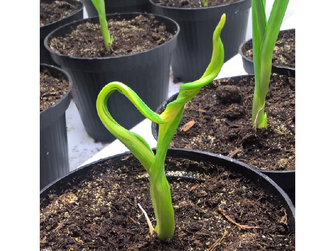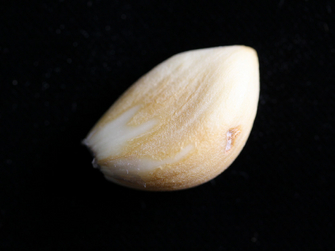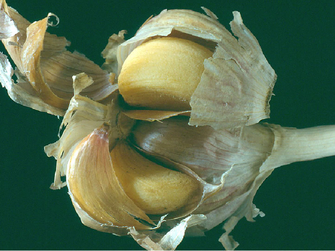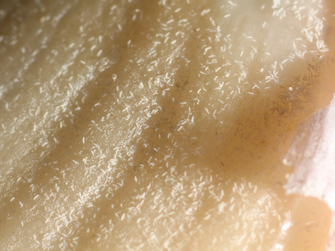Dry bulb mite
Aceria tulipae
Profile
Garlic gall mite is one of the most important pests in the cultivation of garlic. Symptoms of damage are, in addition to restrictions in plant growth in the field, discoloration and withering of the garlic cloves in storage. Control of the mites is difficult, as they usually only become visible on stored garlic.
Appearance
Adults have two pairs of legs on the anterior body, while the posterior part of the body is cylindrical in shape and shows external ringing. Two longer, conspicuous bristles are visible at the end of the body. Because these mites are very brightly colored and only 0.3 mm long, they are not visible to the naked eye - a magnifying glass or microscope is required to observe them. They are most easily identified by the symptoms of damage. However, the exact identification can only be done by a specialist: for this purpose, features of the body surface, such as position of the bristles are important, as well as a so-called feather bristle on the front legs.


Biology
The garlic gall mite - also called the tulip gall mite - belongs to the gall or curly mites (Eriophyidae), a family within the large group of mites. Despite its name, however, this species does not produce galls. During the growing season, the mites live on green plant parts of garlic and other lily plants. They prefer young tissue, especially stomata of not yet unfolded leaves and inflorescences. From the inflorescences, they can then very easily migrate to brood bulbs.
The mites can develop optimally at a temperature of 25°C and a relative humidity of 80-95%. Each female lays about 25 eggs, from which larvae hatch after a short time. The incubation period is two days at 25 °C and about one month at 2 °C. The mites pass through two larval stages in their development. To feed, they superficially bite the tissue of the garlic plant with their very short, pincer-like mouthparts. Only in very severe infestations are symptoms of damage seen on the leaves, which twist in easily and stick to each other as they unfurl.
When the garlic is pulled in, they attach themselves both to air bulbs but also to the "ground cloves", where they are very well protected between the garlic clove and the sheathing leaf surrounding it. If the temperature is high enough, they can multiply well here and are often found in the small dimple below the tip of the clove. Low infestation is practically undetectable, so it can easily happen that slightly infested toes are stored for harvesting. However, if stored too warm (summer temperatures, not refrigerated), the mites multiply rapidly, so that the toes dry out easily as a result of punctures.
On heavily infested inflorescences in the field, flower bugs(Orius species) and predatory mites from the family Tydeidae were found as natural enemies. It is likely that garlic gall mites can overwinter in our field - in any case, the animals withstood great cold of -24 °C well in laboratory tests.
Damage symptoms
The sucking activity of the garlic gall mites causes yellowing and twisting of the leaves. Younger leaves get stuck due to the lack of development of older leaves. Heavily infested air bulbs lag behind in growth, so that the size of the air bulbs varies greatly.
Heavily infested garlic cloves in storage can be recognised by the fact that they become very light as a result of drying out. They are easy to squeeze and have a yellowish-brown colour when peeled.
In addition, the sucking activity can lead to the transmission of allexiviruses such as Garlic virus A to Garlic virus E and Garlic virus X.




Economic importance
Despite its tiny size, the garlic gall mite is one of the most important pests in the cultivation of garlic in agriculture. This is because it usually multiplies unnoticed in the store, can cause massive damage through its sucking activity on the cloves and control is no longer possible at this stage.
Prevention and control
- Use healthy planting material. Under no circumstances should untested consumer goods be used, as these are sometimes infested.
- In the case of self-propagation via air bulbs, the inflorescences should not be left on the plant until the bracts open, as the mites can easily migrate into flowers and thus onto air bulbs.
- The crop should be stored in a cool, dry place to prevent any mites that may be present from multiplying. The individual batches of garlic should be stored at a certain distance from each other so that no migration from infested to healthy cloves can take place.
- As a chemical control method for plant protection, the literature mentions treatment with sulfur dust in storage and fumigation of the crop in tightly closed rooms by licensed companies.
Specialized information
Publications
Moyses, A., 2016. the garlic gall mite (Aceria tulipae): a hidden pest of garlic. Vegetable Crop Practice, 23(1), 16-17.
Investigations
To ensure that garlic growers can continue to have confidence in the health of their seedlings, garlic seedling surveys are essential to ensure freedom from infestation by garlic gall mites throughout the growing season and into storage.
At the Sustainable Cropping Department, we conduct testing of harvested or planted material for Aceria tulipae.
Last updated: 10.03.2025
automatically translated